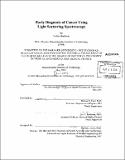Early diagnosis of cancer using light scattering spectroscopy
Author(s)
Backman, Vadim, 1973-
DownloadFull printable version (13.13Mb)
Alternative title
Early diagnosis of cancer using LSS
Other Contributors
Harvard University--MIT Division of Health Sciences and Technology.
Advisor
Michael S. Feld and Lev T. Perelman.
Terms of use
Metadata
Show full item recordAbstract
This thesis presents a novel optical technique, light scattering spectroscopy (LSS), developed for quantitative characterization of tissue morphology as well as in vivo detection and diagnosis of the diseases associated with alteration of normal tissue structure such as precancerous and early cancerous transformations in various epithelia. LSS employs a wavelength dependent component of light scattered by epithelial cells to obtain information about subcellular structures, such as cell nuclei. Since nuclear atypia is one of the hallmarks of precancerous and cancerous changes in most human tissues, the technique has the potential to provide a broadly applicable means of detecting epithelial precancerous lesions and noninvasive cancers in various organs, which can be optically accessed either directly or by means of optical fibers. We have developed several types of LSS instrumentation including 1) endoscopically compatible LSS-based fiber-optic system; (cont.) 2) LSS-based imaging instrumentation, which allows mapping quantitative parameters characterizing nuclear properties over wide, several cm2, areas of epithelial lining; and 3) scattering angle sensitive LSS instrumentation (a/LSS), which enables to study the internal structure of cells and their organelles, i.e. nuclei, on a submicron scale. Multipatient clinical studies conducted to test the diagnostic potential of LSS in five organs (esophagus, colon, bladder, cervix and oral cavity) have shown the generality and efficacy of the technique and indicated that LSS may become an important tool for early cancer detection as well as better biological understanding of the disease.
Description
Thesis (Ph. D.)--Harvard--Massachusetts Institute of Technology Division of Health Sciences and Technology, 2001. Includes bibliographical references.
Date issued
2001Department
Harvard University--MIT Division of Health Sciences and TechnologyPublisher
Massachusetts Institute of Technology
Keywords
Harvard University--MIT Division of Health Sciences and Technology.